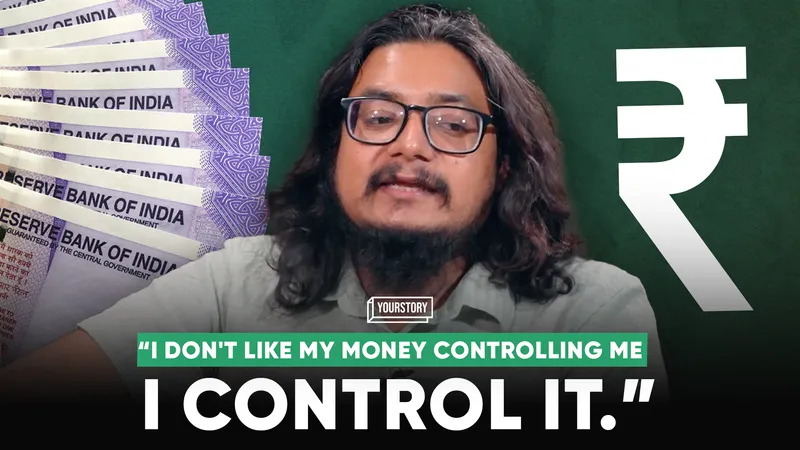On becoming a creator in Bharat: Lessons from Manish Pandey’s transformational journey
The brand consultant with nearly 120,000 followers on Twitter opens up to YourStory Founder and CEO Shradha Sharma on his journey and how it influenced his role in deepening the roots of India’s creator economy.
Pain and suffering can influence our lives in one of two ways. Either break us to the extent that we lose all hope and decide to live in oblivion. Or transform us and make us more compassionate and altruistic.
Brand consultant Manish Pandey’s journey to becoming an enabler of creators from India’s small towns and cities was not easy, but in that he found his purpose quite early.
“I feel I should just be available for anyone to pluck ideas off of me,” he says in an interview with YourStory CEO and Founder Shradha Sharma. “All my organs are donated as well.”
In India, more than 1,200 YouTube channels have at least 1 million subscribers, with 95% of viewers consuming content in local languages and dialects. The platform expects a 40% increase in content created in Indian languages such as Bengali, Marathi, Tamil, and Telugu.
And it's creators in those local languages and dialects whom Manish seeks to nurture.
Humble beginnings
Success was not easy for Manish, but he acknowledges that his journey is similar to that of “90% of Indians”.
His tryst with pain and suffering at a young age, he says, forced him to confront realities and develop an awareness. As an enabler behind multiple industry successes, Manish says he owes his ability to make decisions and critical judgements to his early life experiences.
“One needs to make friends with pain. If you are weak, the world will pull you down faster than you realise. It’s futile even trying to play the victim card.”
That independent streak is evident in his relationship with money as well. How he acquires, spends and manages money is largely based on his own personal values.
“I don't like the idea of my money controlling me, instead it’s me who controls it,” he says. “I decide how much I need and spend, and I charge my clients accordingly, even when it’s far below the industry average.”
Creating creators of Bharat
Manish is often referred to as the ‘Bade Bhaiya’, or elder brother, of India’s creator economy. That moniker stems from his efforts to afford young creators opportunities he never got himself—by supporting their dreams with the tools they need to realise them.
He highlights the stark contrast between TikTok and , and the significant societal perspective shift associated with the creators engaged with those respective apps.
India has an about 50 million such creators, and the leading ones among them are estimated to earn Rs 3-15 crore a year, as per a report by PGA Labs.
The firm estimates the size of India’s creator economy at $300-400 million, and that of the global market at $104 billion.

This economy is more a non-metro phenomenon today, representing significant opportunities for involvement in broader social and geographical cultures.
Manish emphasises on the democratisation of this space, with its penetration in India’s Tier-II and Tier-III cities and towns.
“If Baba Jackson, a creator hailing from a small town in Rajasthan, is able to open his own dance academy, and collaborate with the biggest film stars by uploading dance videos from his phone, then such initiatives should be appreciated,” he says.
Talking about how creators associate their self worth with numbers on social media, Manish preaches a more nuanced approach.
“It is important to be philosophical and ask the important questions: What is my need and greed? How much is enough?” he says, adding, “Getting stuck in the race is a sure-shot way of getting one’s creativity killed.”
He believes self-determination is crucial to succeeding in the creator ecosystem. “In fact, if one has a cellphone, computer and internet, 80% of the work is done. The remaining 20% is courage and hard-work.”
Rise of influencer marketing
Influencer marketing is emerging as a potentially large sector in India. It is currently valued at Rs 900 crore and expected to reach over Rs 2,000 crore by 2025, as per The India Influencer Marketing Report by INCA.
“India is not far away from having 100 individuals with 100 million followers,” says Manish.
There is a considerable change now in using celebrities to endorse a brand versus an influencer. In 2021, celebrities had only 27% of the share of marketing campaigns, and influencers the remaining 73%.

This growth is seen across sectors and geographies.
Manish says the potential of influencer marketing in Tier II and Tier III cities is yet to be unlocked.
“A local jeans manufacturing company in Patna may not have understood the potential of using influencers for their marketing. But when they do realise the value, they will tap into local influencers for advertisements,” says Manish.
Key to becoming an influential creator
Manish has specific advice for upcoming creators, and the first of those is to not be one full-time, at least to begin with. “Don’t do it full-time from day one, but rather keep it complimentary with any other thing that you are doing.”
He also suggests creating a content schedule with enough material for at least two months, and that consistency is important in becoming an influential creator. A creator’s habit and commitment becomes their consumers’ habit and consumption, he says.
Manish also advises persistence—to allow a minimum of two years to become a successful influencer—and understanding the platform and analysing data and trends to be better prepared.
On the comments section, which at times can be toxic or unnerving in the least, Manish has an interesting take: “Your comments section is your university,” he says, “and it will tell you what you can do better.”
Edited by Feroze Jamal







